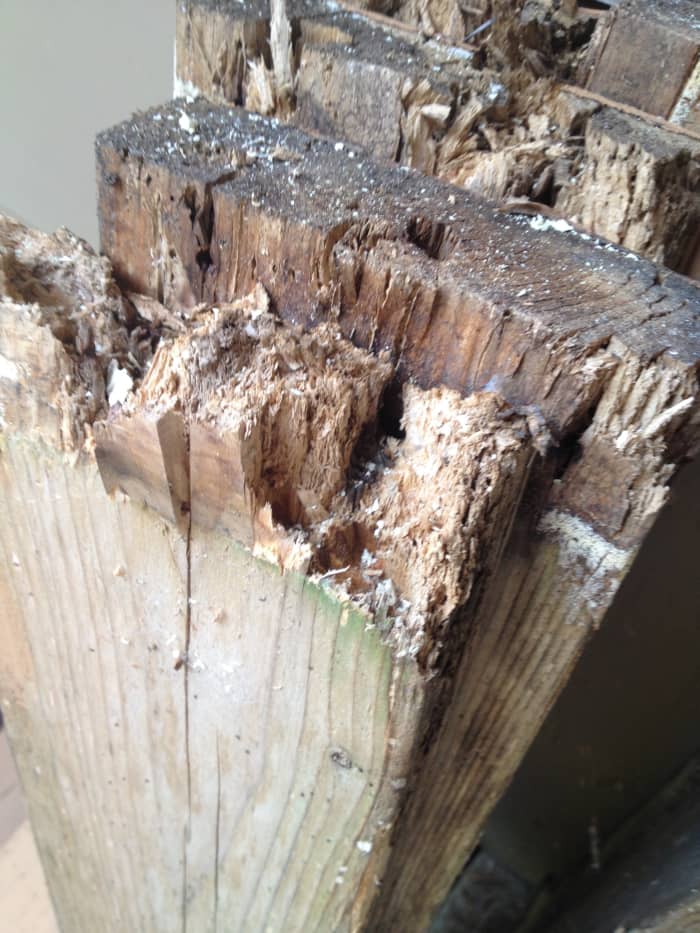How To Repair Rotting Deck Stair Stringer
How to Repair Wood Rot on Your Outdoor Deck: A General Overview
Currently employed as a physical therapist assistant specializing in elder rehabilitation and didactics/preparation.
Wood Rot: A common nemesis on most homes.
If you lot've owned a home for whatsoever length of time, more than probable you've experienced forest rot in some way. For us, it'due south been our deck.
Congenital of cedar over 14 years ago, our deck has provided quite the challenge when it comes to wood rot repair. This hub will briefly overview my latest deck repair project. Hopefully it will assistance you as well by keeping your deck safe and wood-rot free!
The Process:
The post-obit pictures tell the story: lots of woods rot and lots of time spent repairing it. Hither'due south a general guideline for basic forest rot repair that can be modeled for most other wood rot issues.
Hither's the club for tackling this project:
- Carefully remove primary rotted wood. Remove but what is necessary every bit yous'll demand equally much solid woods as possible to reinforce. Examples of primary wood pieces tin can be (non an exhausted listing): Deck and stair treads, stair stringers, trim boards, window trim, siding, fascia, etc. Basically anything fabricated of forest exposed to elements or potential water damage.
- Remove additional wet and dry root with an advisable tool. Make sure ALL of the rot is removed. If there's not enough viable wood remaining, yous'll have to replace the entire wood construction.
- Protect exposed woods with a suitable forest hardener and permit to dry.
- Fill void/cavity with an appropriate forest filler and allow to dry.
- Sand and level to appropriate height and dimension.
- Supercede rotted wood pieces and secure with advisable exterior wood fasteners; in this example, stair treads are being replaced.
All in all, non a lengthy procedure, merely it does have fourth dimension to do it properly to avert time to come woods rot.

Ends of the cedar stair treads after removing from partially-rotted stringers. Non a safety pace to say the least!

Cavity created later on removing the rotted woods. I used a pocket-sized, water ice-pick-like tool to remove the rot. Make sure all the rot is gone, or you'll be doing this again later.

Some other image of a partially rotted stringer and adjacent skirt board. Luckily, there was enough solid wood remaining to fill and adhere additional support.

Still more than rot with all the loose debris removed with compressed or blown air.

Wood hardener used to treat good forest exposed past crenel.
Scroll to Continue

Applying the wood hardener.

Woods hardener after drying for a few hours.

Repaired stringer and treated woods rot.

Wood filler chosen to fill voids. You can utilise other products as well; I've just had adept luck with this every bit it drys quick and sands easily after curing, non to mention information technology cleans upwards easily with water.

Wood filler after drying and shaping.

Another view of cured wood filler with stringer reinforcement attached.

Stringer reinforcement with liquid nails equally a binder.

Stringer reinforcement in place with 3" deck screws used to attach.

New treads solidly in place and gear up for use. No more unsafe steps!
- Replacement forest treads: Pressure treated 2 ten 6 x 8 and 2 x 6 ten 10 as needed.
- Power miter or circular saw
- Tape measure
- 3" deck screws (amount will vary)
- Ability drill
- Liquid nails approved for exterior employ
- Irksome or appropriate wood removal tool; choices are many.
- Wood hardener with application brush
- Wood filler with application tool; I used a 1" putty knife
- Sand paper and three/4" chisel to shape wood filler
- Blower capable of removing all debris from cavity later on rough removal; I used an air compressor with air nozzle zipper.
- PATIENCE as this project takes a fair amount of time!
-
Good luck!
© 2022 Rob Jundt
Related Articles
Source: https://discover.hubpages.com/living/How-to-repair-wood-rot-on-your-deck-General-overview

0 Response to "How To Repair Rotting Deck Stair Stringer"
Post a Comment